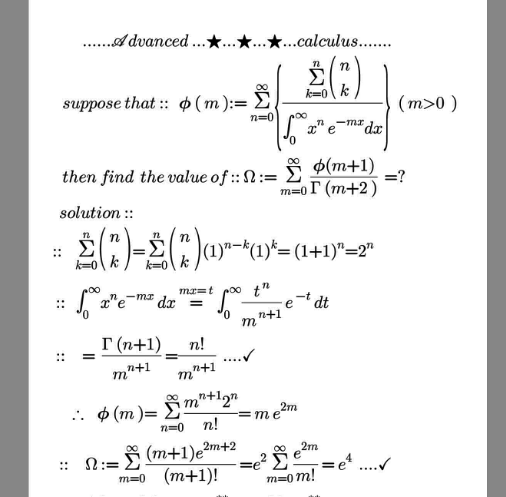
Question and Answers Forum
AllQuestion and Answers: Page 745





Pg 740 Pg 741 Pg 742 Pg 743 Pg 744 Pg 745 Pg 746 Pg 747 Pg 748 Pg 749
|
Question and Answers Forum |
AllQuestion and Answers: Page 745 |

|

|
| Find the coefficient of x^(50) in the expression (1+x)^(1000) +2x(1+x)^(999) + 3x^2 (1+x)^(998) +...+1001x^(1000) |
| (√x)+(√y)=3 and (√(x+5))+(√(y+3))=5 find x and y |

|
| Let f define such as f(1)=1,f(3)=3 ∀ n≥2 , f(2n)=f(n) f(4n+1)=2f(2n+1)−f(n) f(4n+3)=3f(2n+1)−2f(n) 1)Prove that ∀ n , f(n) is odd 2)Prove that if f(a_n )=a_n , then a_n =2^n −1 or a_n =2^n +1 |
| prove that are axactly 1729 positive integer solutions to the below equation 4x^4 +3y^3 +2z^2 +t=4311 |
| by use Gamma function prove (1) ∫_0 ^( (π/8)) cos^3 4xdx=(1/6) (2) ∫_0 ^( π) sin^6 ((x/2))cos^8 ((x/2))dx=((5π)/2^(11) ) |
| ∫_0 ^∞ (dx/((1+x^5 )^5 ))=((798(√2))/(5^5 (√(5−(√5)))))π |
| ∫_0 ^( 1) ((√x)/( (√(1−x))+(√x)))dx |
| ∫_( 0) ^( ∞) ((sin(x^2 −arctan((1/x^2 ))))/( (√(1 + x^4 )))) dx |
| IF ((x^3 +1)/(x^2 −1))=x+(√(6/x)) 6x^2 −5x+4=?? |
| (1/((1−x)^n ))=( ((n),(0) ))+( ((n),(1) ))x+( ((n),(2) ))x^2 +( ((n),(3) ))x^3 +... |
| ∫_0 ^(π/2) sin^2 (x)cos^6 (x)dx |
| ∫_0 ^∞ ((ln^2 x)/(x^2 +a^2 ))dx=(π/(8a))(π^2 +4ln^2 a) ,a>0 |
| ∫_0 ^∞ ((ln x)/(x^2 +a^2 ))dx=(π/(2a))∙ln a ,a>0 |

|
| (√((3000000 + 3000000)/(4000000 + 4000000))) = ? |

|
| ∫_a ^( b) f(t)g′(t)dt= ? |
| A man has ′n′ pair of black shoes and ′m′ pairs of brown shoes. Man hurriedly wear two shoes. What is probability that both of them are black? |
| ∫ ((cos x+(7)^(1/3) )/(sin x+(√6))) dx =? |
| Σ_(k=1) ^∞ (((−1)^k (2k−1))/k^2 ) =? |
| How do you find a point on the curve y = x^2 that is closest to the point? (16, 1/2) |
| ∫_0 ^1 e^x^2 dx=(e/(1+(2/(1+(4/(1+(6/(1+(8/(1+((10)/(1+...)))))))))))) |
| 𝛗=∫_0 ^( 1) ((ln(1+x+x^2 ))/x)dx φ=∫_0 ^( 1) ((ln(1−x^3 )−ln(1−x))/x)dx =Ω+(π^2 /6) Ω=−Σ∫_0 ^( 1) (x^(3n−1) /n)dx=−Σ_(n=1 ) ^∞ (1/(3n^2 )) =((−π^2 )/(18)) .....≽ 𝛗=(π^2 /9) .......(π^2 /9)−(π^2 /(24)) =((5π^2 )/(72)) |
Pg 740 Pg 741 Pg 742 Pg 743 Pg 744 Pg 745 Pg 746 Pg 747 Pg 748 Pg 749 |